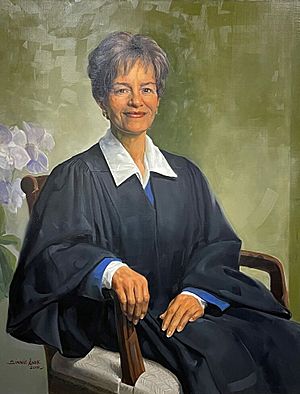Judith W. Rogers facts for kids
Quick facts for kids
Judith Rogers
|
|
|---|---|

Official artistic portrait, 2019
|
|
| Senior Judge of the United States Court of Appeals for the District of Columbia Circuit | |
| Assumed office September 1, 2022 |
|
| Judge of the United States Court of Appeals for the District of Columbia Circuit | |
| In office March 11, 1994 – September 1, 2022 |
|
| Appointed by | Bill Clinton |
| Preceded by | Clarence Thomas |
| Succeeded by | Brad Garcia |
| Chief Judge of the District of Columbia Court of Appeals | |
| In office November 1, 1988 – March 17, 1994 |
|
| Preceded by | William C. Pryor |
| Succeeded by | Annice M. Wagner |
| Associate Judge of the District of Columbia Court of Appeals | |
| In office September 15, 1983 – March 11, 1994 |
|
| Appointed by | Ronald Reagan |
| Preceded by | Catherine B. Kelly |
| Succeeded by | Vanessa Ruiz |
| Corporation Counsel of the District of Columbia | |
| In office April 12, 1979 – September 15, 1983 |
|
| Mayor | Marion Barry |
| Preceded by | Louis Robbins (Acting) |
| Succeeded by | Inez Smith Reid |
| Personal details | |
| Born |
Judith Ann Wilson
July 27, 1939 New York City, New York, U.S. |
| Parent | John Louis Wilson Jr. (father) |
| Education | Radcliffe College (BA) Harvard University (LLB) University of Virginia (LLM) |
Judith Ann Wilson Rogers was born on July 27, 1939. She is a very important judge in the United States. She serves as a senior federal judge on the United States Court of Appeals for the District of Columbia Circuit. This court handles appeals from other courts in the Washington D.C. area.
Contents
Early Life and Education
Judith Ann Wilson was born in New York City. Her father, John Louis Wilson Jr., was a famous architect. He designed many public buildings in New York City.
Judith Rogers went to college at Radcliffe College, where she earned a degree in 1961. She then studied law at Harvard Law School, getting her law degree in 1964. Later, she earned another law degree from the University of Virginia School of Law in 1988.
Early Career in Law
After finishing law school, Judith Rogers worked as a law clerk at the Juvenile Court in Washington D.C. from 1964 to 1965. A law clerk helps a judge with their work.
She then became an Assistant United States Attorney for Washington D.C. from 1965 to 1968. This means she worked for the government to bring legal cases. She also worked as a lawyer for people who needed legal help in San Francisco.
From 1969 to 1971, she was a trial lawyer for the United States Department of Justice. She then helped a special group in Congress that was looking at how the District of Columbia government was organized. She helped create laws that gave Washington D.C. more control over its own government, which is called "home rule."
From 1972 to 1979, she worked on laws for the D.C. government. During this time, Washington D.C. held its first elections for its city council and mayor. In 1979, Judith Rogers made history. She became the first woman to be the corporation counsel for the District of Columbia. This role is like the chief lawyer for the city.
Becoming a Judge
In 1983, Judith Rogers became an Associate Judge on the District of Columbia Court of Appeals. This is the highest court in Washington D.C. She served as the Chief Judge of that court from 1988 to 1994. The Chief Judge is the main judge who leads the court.
Federal Judicial Service
On November 17, 1993, President Bill Clinton chose Judith Rogers to be a judge on the United States Court of Appeals for the District of Columbia Circuit. This is a very important federal court. The United States Senate approved her appointment on March 10, 1994. She officially became a judge on March 11, 1994. She was the fourth woman ever to be appointed to this court.
On September 1, 2022, Judge Rogers took on "senior status." This means she still works as a judge but with a reduced workload. It allows her to continue serving while also making room for a new judge to be appointed.
Important Cases and Decisions
Judith Rogers has been involved in many important cases. Here are a few examples:
- In March 2017, she wrote an opinion about the First Amendment, which protects freedom of speech and the press. She argued that the public should have a right to see court documents about prisoners.
- In August 2017, she disagreed with part of a court decision. The court found that some mandatory sentences were too harsh. She believed that these sentences were unconstitutional because they were cruel and unusual punishments.
- In February 2020, she disagreed with the majority of judges in a case about a subpoena. A subpoena is a legal order to provide information. The case was about whether the U.S. House of Representatives could force a former White House lawyer to testify.
- On November 12, 2021, Judge Rogers wrote the decision for the court that allowed the U.S. Postal Service's regulator to set higher mail rates. All the judges on the panel agreed with her decision.
See also
- List of African-American federal judges
- List of African-American jurists
- List of first women lawyers and judges in Washington D.C.

